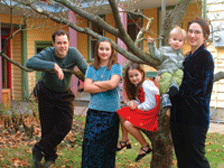
Sleeping Queens – Our Life in Cards
The holiday season is the perfect time for family and friends to gather around and play their favorite games – or try out a brand new one like Sleeping Queens. One of this year’s most popular games, Sleeping Queens is proof that a six-year-old, with the right cards, can become an inventor and license her intellectual property rights. Sleeping Queens was created by Miranda Evarts, the first child inventor of a game released on the international market. She came up with the original idea and developed the rules with the support of her family. Miranda then landed a successful licensing agreement with an award-winning game company Gamewright.

One sleepless night Miranda, her imagination running wild, played a game in her mind where she rescued queens who had fallen under a sleeping spell. She got up, went to her parents and announced: “I made up a game!” Promptly tucked back into bed, she championed the cause of the sleeping queens in her dreams all night long. The next morning, an enthusiastic Miranda outlined her ideas to her parents, older sister, Madeleine, and baby brother, Stephen. The sleeping queens were embraced and adopted as a family project.
“My family and I had been playing lots of card games to help with simple math skills,” Miranda explained. Her mother, Denise Evarts added: “Games bring families and friends together. We have game night at our home about once a week, and when friends visit they should be prepared to play!”
The Evarts started playing the new game by drawing first the queens, then kings, knights and dragons on regular playing cards – adding a whole panoply of characters to introduce more fun. They based them on everyday life, concocting the Tie-Dye King, inspired by Mr. Evarts’ tie-dye clothes and the Baby Queen from Mrs. Evarts’ work as a doula (a provider of non-medical support in the childbirth process). “We have the Pancake Queen and we always ate pancakes,” explained Madeleine. “It was just our life in cards.”

When they finished developing the full game, Mr. and Mrs. Evarts initiated contact with Gamewright via e-mail. “I knew from the beginning that I wanted to approach Gamewright, because we loved their other games,” said Mrs. Evarts. The company found Sleeping Queens unique and interesting, and requested a prototype. “It didn’t take more than a couple of test sessions to notice that we had a unique game on our hands,” said Jason Schneider, Gamewright Product Development and Marketing Manager.
“They loved the name and idea right away” said Mrs. Evarts. “They told me what they liked and didn’t and we got back to work. It was not always easy to go back and change things, especially for Miranda, but we kept that vision of the game on the shelf.”
The negotiations with Gamewright over the IP rights went well. “It was actually a very smooth transaction and it only took about six months from idea to license agreement,” explained Mrs. Evarts.
Following the success in the original English version, Sleeping Queens is being translated into various other languages. As for Miranda, her imagination is still running wild, dreaming up new games.
By Susie Chang, WIPO Communications and Public Outreach Division.
The WIPO Magazine is intended to help broaden public understanding of intellectual property and of WIPO’s work, and is not an official document of WIPO. The designations employed and the presentation of material throughout this publication do not imply the expression of any opinion whatsoever on the part of WIPO concerning the legal status of any country, territory or area or of its authorities, or concerning the delimitation of its frontiers or boundaries. This publication is not intended to reflect the views of the Member States or the WIPO Secretariat. The mention of specific companies or products of manufacturers does not imply that they are endorsed or recommended by WIPO in preference to others of a similar nature that are not mentioned.